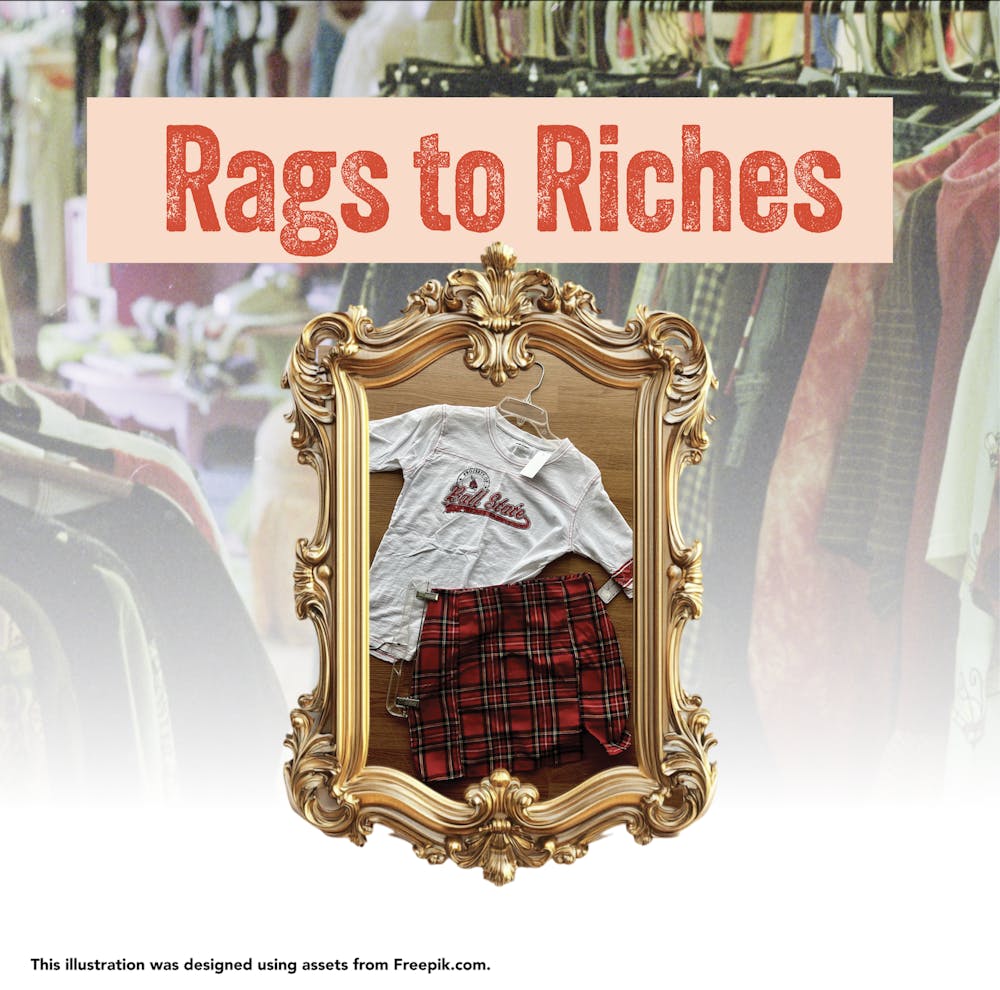Reduce, reuse, and recycle. This is something that many people have heard since elementary school, and, in some ways, they’ve taken it to heart.
While thrifting isn’t new, small businesses have begun thriving off of hand-me-downs, vintage aesthetics, and discounted pricing. According to a study conducted by Comillas Pontifical University economics and business administration professor Carmen Valor, used garments were seen as a low-status good, and, therefore were stigmatized.
After American thrift stores were first established in the late 19th century, the Salvation Army and many other Christian ministries found that

they could use this as a funding source for their outreach programs. Today, well-known thrift stores like Goodwill, as well as the Salvation Army, contribute to the $53 billion that second-hand products supply to the United States economy, according to the Salvation Army.
During the time of World War II and the Great Depression, there was an influx of discounted clothing, which tended to be used. Poor economic conditions forced Americans to rely on thrift stores because it was the only affordable option.
After overcoming the economic depression, the Salvation Army records a decline in a desire to thrift. Being able to purchase new goods quickly became a reflection of success and wealth.
Today, the boom in popularity for thrifting can be attributed to three main causes: a crave for a unique style, a desire to be more sustainable, and, much like during the Great Depression, a need for affordable clothing, according to Haven House Thrift Store.
Because of the rise of the internet, the Salvation Army has found it’s easier than ever to buy second hand. Thrifting can be done online, thanks to apps such as Depop, Poshmark, and Thredup.
Despite thrifting apps becoming more prevalent, small thrift shops are still popping up around the country. In Muncie, this is no exception.
Lily Brannon opened up Lily’s Labyrinth in the McGalliard Square Shopping Center in the spring of 2022 to “make some extra cash.” However, her experience with thrifting started long before that. With encouragement and donations from her friends, Lily was able to start building one of the most popular thrift stores in Muncie.
“I’ve hand-picked every piece and decided that it was cute enough for me to sell,” Lily says.
Another thrift store, Well Made Vintage is located in The Village. Anthony Edwards is one of the co-owners, and emphasizes that living a sustainable lifestyle means avoiding buying clothing from fast fashion websites such as SHEIN, a global fashion online retailer.
According to Earth.org, fast fashion is clothing that is made in mass quantities and follows a certain trend for the time it’s being made. It is meant to be sold for cheap and fly off of shelves quickly.
“I see when people do reels with their SHEIN hauls or [shopping] hauls from whatever other fast fashion brand, and those clothes not only are made by essentially slave labor, [but] those clothes within the first year, a lot of times, are already taken to a thrift store,” Anthony says.
In 2023, 24 U.S. Congress members wrote a letter to the U.S. Securities and Exchange Commission, asserting that there was “scientific evidence” that SHEIN utilized cotton from the Xinjiang Uyghur Autonomous Region, claiming that it can be assumed to be forced labor.
Anthony also noticed that the quality of the clothing made through fast fashion, isn’t what thrifters are seeking. Their customers are looking for clothing that is made to last. Earth.org found that of the 100 billion garments produced in a single year, over 1 billion tons end up in landfills.
Despite the rise in more stylistic-focused thrift stores, there are many Christian-based organizations that run thrift stores. According to their website, Muncie Mission Ministries provides faith-based homeless shelters as well as family services, community meals, and addiction recovery. They also have five thrift stores located in and around Muncie.
Attic Window, their thrift store, accepts many donations, including household items, clothing, and even cars.

Leigh Edwards, Vice President of Community Engagement at the Mission, shared thrifting helps community members save money. When trying to help people get back on their feet, Leigh says saving money on clothing can be the difference between buying canned or fresh groceries for someone who lives below the poverty line.
“Let’s say we’re talking about a family with kids, being able to purchase all your kids clothes at a thrift store, as opposed to Walmart or Target . . . you’re definitely going to experience significant savings,” Leigh says.
Most of the clothing that is donated to the Mission goes to their programs and community members that may need it. Leigh says retail “gets second dibs.”
With the clothing that is too tattered to be brought into the programs or sold, Muncie Mission has a palletizer. It is used to make rags that are sold to bigger companies, which also fund the various programs.

Leigh also works in collaboration with Ball State Fashion Industries Studies to set up programs that allow Ball State students to work with the thrifted items that are not given to the programs or are not sold in the thrift stores. One of the people she works with is assistant lecturer of fashion industries studies Audrey Robbins.
Robbins is currently working on two different projects with Attic Window. One is a styling class, and the other is a special topics class. The styling class is focusing on taking pieces from Attic Window and turning them into outfits.
“Each group has a social media campaign they are creating, and they’re going to be shared on the Ball State fashion social media pages,” Robbins says. “It will be noted that you can buy those pieces at Attic Window.”
The special topics class is taking unrecyclable and unwanted items and completely changing them into something new. Robbins says, everything is 100% “recycled, upcycled, reimagined, [and] redesigned.”
Whether it’s a pair of shoes, clothing, or home furniture, the clothing that finds its way to thrift stores used to be loved by someone else and is getting a fresh start, says Leigh.
“Everyone and everything deserves a second chance,” Leigh says.
Contact Lilly Arnholt via email at lilly.arnholt@bsu.edu





